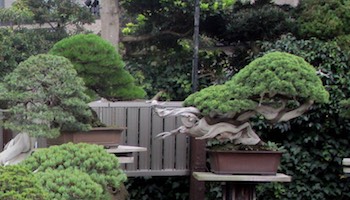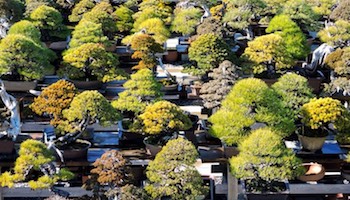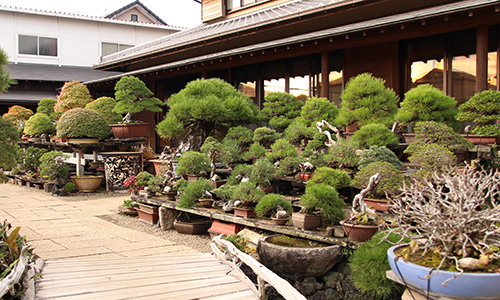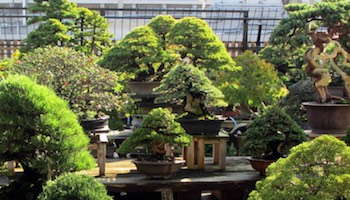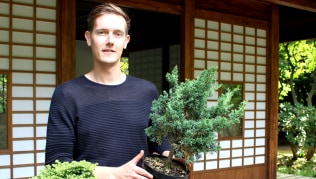Where to go
The Kanto area (greater Tokyo region) is home to the most famous Japanese Bonsai nurseries, while Kyoto houses the most impressive Japanese gardens and other cultural sites. Personal highlights included visits to Suzuki, Kimura, Omiya, the top-three Japanese gardens and the uncountable number of superb Kyoto gardens. If time permits, schedule a visit to Kinashi Bonsai village as well. Some non-Bonsai related highlights included attending a Sumo tournament day, indulging on some of the best food in the world, making a trip to the wonderful Shikoku island and skiing in the Japanese Alps. A Bonsai holiday to Japan will very likely result in new personal interests, like gardens, Suiseki, Ikebana, Manga, etc!
When to go
Most organized Bonsai tours to Japan depart early February, for the one reason to coincide with the famous Kokufu-ten Bonsai exhibition. The warmer and climatically more stable seasons of spring and autumn are much better times to visit Japan though. When visiting in spring, make sure your trip coincides with Shunga-ten (Shohin exhibition Osaka, late March) and the cherry blossoms (late March/early April). For the most intense autumn colors, visit in November, possibly coinciding with the Shuga-ten (Shohin exhibition Tokyo, early November) or Taikan-ten (Bonsai exhibition Kyoto, mid November).
Other main Bonsai exhibitions in Japan include the Gafu-ten (largest Shohin exhibition, Kyoto early January), Koju-ten (main Satsuki tree exhibit, Kanuma early January), Sogo-ten (Suiseki exhibit, Tokyo late March) and the Satsuki festival (Satsuki trees, Tokyo early June).
Bonsai sights in Japan
The main Bonsai sights in Japan include the Bonsai villages in Omiya and Takamatsu (Kinashi), the gardens owned by mr. Kimura and mr. Suzuki, Osaka based Fujikawa Kouka-en, the Kyoto based Koju-en Shohin nursery, several famous Bonsai exhibitions and Kunio Kobayashi’s Shunkaen Bonsai museum in Tokyo.
Japanese gardens in Japan
Japan’s top three gardens are Kairakuen (Mito), Kenrokuen (Kanazawa) and Korakuen (Okayama). Kyoto offers many stunning gardens, including Ginkakuji, Kennin-ji, Daisen-in, Koto-in, Ryogen-in, Kinkaku-ji, Ryoan-ji and Ninna-ji. Finally, Ritsurin garden in Takamatsu is worth going when visiting Kinashi Bonsai village.
Select your topic of interest below in the list of articles.
Omiya Bonsai village
The gardens can be visited on a day-trip from Tokyo, but make sure you arrive early to have the place for yourself. Please note most gardens are closed on Thursdays.
Shinji Suzuki's Bonsai garden
The masterpiece Bonsai trees are displayed spaciously and very orderly, giving visitors the opportunity to appreciate the trees from all sides. From the entrance of the museum you enter the garden through a gallery of Bonsai and walking into two famous and very large pine trees.
Masahiko Kimura's Bonsai garden
His garden is like a museum and anyone interested in Japanese Bonsai will recognize at least half his collection from magazines and websites.
Shunkaen Bonsai garden
The garden is an absolute highlight and should not be missed. When entering the garden the first thing you are likely to note is the stunning 1000 year old pine tree in front of the house, the masterpiece of Mr. Kobayashi’s collection.
Kinashi Bonsai village
The area has a history of growing Bonsai for over 250 years and it has an 80% share in the domestic market of pine trees. About a hundred nurseries are located here, of which about a dozen can be considered high-end (training high quality trees). Many large fields of young nursery plants are grown in the area too, making the entire neighborhood feel like heaven on earth.
Taishoen Bonsai garden
Mr. Nobuichi Urushibata (a well known Bonsai master) and his son, Taiga Urushibata (who apprenticed at mr. Kimura) run the garden in a very professional way and welcome visitors. Taiga speaks English, which is very convenient if you visit the garden or when you are interested to study Bonsai. They accept foreign students for studies of a few months, which receive very positive reviews.
Uchiku-tei (S-Cube)
The company of mr. Morimae is named S-Cube, and has a small store located in Ginza (Tokyo) and the stunning main garden located in Hanyu. Here, several thousand Bonsai are displayed, as well as antique Bonsai pots, scrolls and Suiseki.
Aichien Bonsai garden
The garden has been in operation since 1896, founded by mr. Sukijiro Tanaka. Several foreign apprentices have studied here, including Peter Tea and Juan Andrade.
Koju-en Shohin garden
Owned by Tomohiro Masumi (one of the most respected and well-known Shohin masters in Japan), this nursery is very centrally located near Toji temple. Bonsai classes (on Bonsai and Shohin care) are offered every 4th Sunday of the month.
Koukaen Bonsai garden
藤川光華園 盆栽 - The Fujikawa Kouka-en garden is owned by Mr. Fujikawa and is located near Osaka, in the suburb of Ikeda. The nursery opened in 1950 and several of its trees entered in the Kokufu-ten in Tokyo since then.
Ueno green club and Nippon Bonsai
上野グリーンクラブ & 日本盆栽協会 - The Ueno Green Club is located at the west part of Ueno Park and is home to several Bonsai shops offering trees, tools and pots. Most stands only open during weekends and the club gets crowded during the Spring Bonsai Festival (early February, scheduled part of Kokufu-ten) when over a hundred stands are set up. The area is closed on Wednesdays.
Morimae Ginza Bonsai shop
Right in the middle of the classic shopping district Ginza you will find this upmarket Bonsai store. Morimae Ginza showcases several beautiful trees and tokonoma displays. On the second floor there is a selection of a few antique pots, tools and two more tokonoma displays. The shop is rather small, but definitely worth visiting as you will probably make it to the Ginza district in Tokyo anyway.
Bonsai exhibitions in Japan
Throughout the year several Bonsai, Shohin and Suiseki Exhibitions are held in Japan. The most important exhibition is the Kokufu-Ten, where the highest quality Bonsai trees of Japan are displayed. The exhibition is held in Tokyo in February. Another key event is the Taikan-ten, held each November in Kyoto. For Shohin lovers the most important show is the Gafu-Ten, also held in Kyoto in January.
Japanese gardens in Kyoto, Japan
Kyoto is absolutely packed with fine Japanese gardens, needless to say a must visit in any Japan itinerary. The gardens, often part of temples or old imperial retreats, are spread around the city (with the exception of Daitoku-ji, which is a large complex housing several temples).
Kairaku-en Japanese garden
偕楽園 - Kairakuen (literally ‘the garden to enjoy with people’) is one of Japan’s top three gardens. Its location close to Tokyo makes for a worthwhile day trip.
Kenroku-en Japanese garden
兼六園 - A former castle garden, Kenrokuen dates back from the 17th century and is rated one of Japan’s top three gardens. The name means ‘combined six’, referring to the six attributes of perfection (seclusion, artificiality, spaciousness, antiquity, abundant water and broad views).
Ritsurin-koen Japanese garden
Located on the slopes of Mt Shiun, Ritsurin-koen (栗林公園) is astonishingly beautiful. It dates back to the 17th century, built for the feudal lord of Sanuki.




